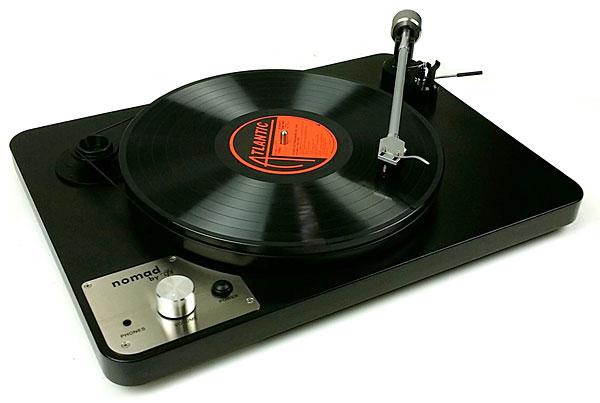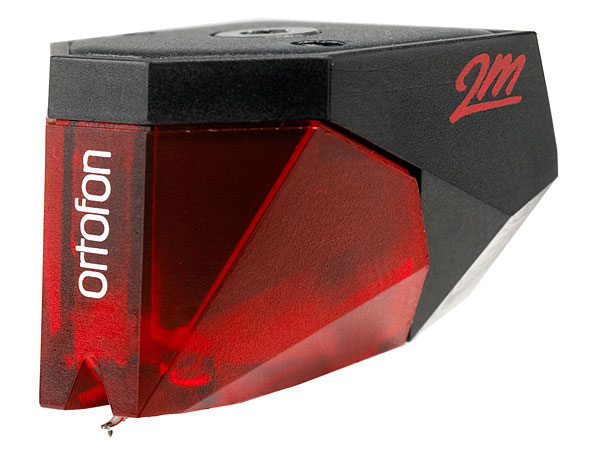| Columns Retired Columns & Blogs |
Very nice trip down memory lane- RJR.
There is always a brother whom over-whelms everyone else w/ the same album/cd played at concert levels...laughing.

By my senior year, however, as my taste in music gravitated toward the Mahavishnu Orchestra, Bartók, and John Cage, I became less welcome in the house's stereo dens. Fortunately, by that time the frat had moved to a new house whose rooms were mostly singles—it was time for me to spend some coin on my first serious stereo rig. I sprang for a Thorens TD-160 turntable with Shure M91ED cartridge, SAE Mark XXX preamp, and Sennheiser HD 424 headphones. The sound was great for its day, but, as the SAE was about the size of my Audio Valve Eklipse line stage, this rig took up a lot of space on my desk and bookshelves.
When Harry Weisfeld and his son Mat set out to design the VPI Nomad, they sought the same functionality as my old college rig: an entry-level combination of turntable, tonearm, and cartridge with a built-in moving-magnet phono stage and headphone amplifier. They had three goals: 1) create the best sound, 2) keep the price under $1000, and 3) provide a user-friendly experience for the turntable tyro. Initially, the Weisfelds wanted to include a pair of Grado headphones, but demurred when, at the last minute, Harry devised some upgrades that would improve the Nomad's sound—and increase its cost. VPI was adamant about keeping the price under $1000, and also concluded that people tend to be picky about which headphones they prefer (footnote 2). They dropped the headphones, and kept the package's price at $995.
Rather an audiophile turntable, the Weisfelds designed the Nomad as a lifestyle product aimed at young people who've never bought a turntable. They included an Ortofon 2M Red moving-magnet cartridge (footnote 3) and a phono stage so buyers won't have to deal with additional purchases to play LPs, and a headphone amp for those who live in small apartments—or dorms, or frat houses—and lack the luxury of being able to use speakers all the time. The Weisfelds also designed the Nomad to be unusually rugged, assuming that turntable neophytes would not take as much care in handling a turntable as a seasoned audiophile. When I removed the review sample from its box, I realized that it was the most rugged turntable I've had in my home, with the exception of my VPI TNT. The Nomad also includes a 10" tonearm that features a gimbaled yoke bearing with a steel rod through it, to make it nearly impossible to break.

The Nomad's platter is machined from MDF and the belt drive provides speeds of 331/3 and 45rpm—to change the speed, you move the drive belt from one pulley to another. A set of robust RCA jacks and a grounding post are on the rear. Cables and ground wire for hooking up the turntable to the line inputs of a preamp or integrated amp are not provided, and the built-in phono stage is not bypassable. The Nomad doesn't come with a dustcover, but the cover designed for VPI's Classic models fits the Nomad perfectly and is available for $369.
The Nomad's solid-state phono stage, designed by Harry Weisfeld and the VPI team, features an integrated circuit that's electrically matched to the impedance and frequency resonance of Ortofon's 2M Red cartridge. Mat Weisfeld claims that the Ortofon 2M Red, which costs $100 if bought separately, will sound better on the Nomad than will any similarly priced cartridge from another manufacturer.
Setting up the Nomad couldn't have been more plug'n'play. Everything is ready to go except the counterweight, and for this, VPI has marked the back end of the tonearm with red tape. You scoot the counterweight up to the edge of the tape, tighten the setscrew with the supplied tool, and the arm is set to the Ortofon 2M Red's recommended tracking force of 1.8gm. I checked this with my Shure stylus pressure gauge, and it was spot on.
Listening
The first thing that struck me about the Nomad's sound was its rich, voluptuous, uncolored midrange. I mined my vocal recordings and reveled in Cassandra Wilson's appropriately chesty-sounding low alto register in "Strange Fruit," from her New Moon Daughter (LP, Blue Note 8 37183 1); Joni Mitchell's pure, crystalline soprano in the title track of Clouds (LP, Reprise 6741); and the angelically seamless blend of the Roche sisters on The Roches (LP, Warner Bros. BSK 3298). Male voices also impressed me. Bob Dylan's voice in "Blowin' in the Wind," from The Freewheelin' Bob Dylan (LP, Columbia CL 1986), were rich, supple, and holographic. The Nomad's lower-midrange performance made it a good match for jazz guitar—and Joe Pass's solo take on John Coltrane's "Giant Steps," from Pass's Virtuoso #2 (LP, Pablo 2310-78), let the rich woodiness of his instrument shine through in the lower-register passages.
High frequencies were also clean, uncolored, and extended. Kraftwerk (LP, Vertigo UK 6641077) predates that band's use of electronic instruments, and on "Megahertz," Florian Schneider gives his flute a workout throughout its entire register—on the Nomad, the woodwind sounded airy and biting, but without a trace of harshness or brittleness. I was also impressed with the bass end of the Nomad's range—all recordings sounded punchy and tight. In Cassandra Wilson's cover of "Strange Fruit," Lonnie Plaxico's double bass is forward in the mix, with a touch of midbass emphasis. The Nomad revealed the bass's thick forwardness in this track, but Plaxico's lines were perfectly clean and uniform, the instrument's woodiness shining through. And when I cranked up "Smells Like Teen Spirit," from Nirvana's Nevermind (LP, Geffen DGC 24425), Chris Novoselic's bass guitar was rich, punchy, and shook the room.
The Nomad resolved an impressive amount of inner detail for so inexpensive an analog rig. It was clearly able to separate the phrasings of the unaccompanied pianists, Bernard Ringeissen and André Gorog, in Stravinsky's Concerto for Two Pianos (LP, Adès 7074). And with Arvo Pärt's Passio, performed by the Hilliard Ensemble conducted by Paul Hillier (LP, ECM New Series 1370), the room sound of St-Jude's-on-the-Hill, London, was clearly delineated, and it was easy to distinguish individual singers in the a cappella chorus.
The VPI's detail resolution made it easy to analyze studio recording techniques with many recordings. With The Manfred Mann Album (LP, Ascot AM 13015), I found it easy to distinguish the overly processed vocals from the more naturally recorded instruments. Speaking of overprocessed studio reverb, even surf guitarist Dick Dale went a bit too far in processing his axe on his Calling Up Spirits (LP, Dick Dale DDLP 184)—I found the album unlistenable on the Nomad. Other turntables resolve more inner detail; for example, the reverb on Mick Jagger's voice in "Lady Jane," from the Rolling Stones' Aftermath (LP, London 820 050-1), was less prominent on the Nomad than I've heard elsewhere.
Footnote 2: I agree. In a recent altercation, I begged my 13-year-old daughter, Caitlin, to do some more research before plunking down serious cash on the pair of headphones she'd chosen for their looks and comfort. "At least read Stephen Mejias's articles before you buy," I pleaded. Her reply was succinct: "I don't care about Stephen Mejias!"
Footnote 3: The Ortofon 2M Red moving-magnet phono cartridge costs $99 when purchased separately. Ortofon, Denmark. US Distributor: 500 Executive Blvd., Suite 102. Ossining, NY 10562. Tel: (914) 762-8646. Fax: (914) 762-8649. Web: www.ortofon.com.

Very nice trip down memory lane- RJR.
There is always a brother whom over-whelms everyone else w/ the same album/cd played at concert levels...laughing.

Don't worry about your daughters headphone choice. Age and maturity are mutually exclusive when it comes to kids.
One day you'll wake up and the pop music and trendy cans will be in the rubbish bin and you'll hear strains of the Grateful Dead coming from her room.
Then, you can smile.

Believe or not I still have/use my Sanyo Direct Drive TP-1020 TT from 1978, bought it via mail order from Soundwarehouse in San Luis Obispo, CA. Recently purchased a Ortofon 2M Red (did have a budget AT) along with a Grado ME+ for my Beatles in Mono box set. Looking to upgrade to a VPI Scout just hard to pull the trigger $$$

I can't get em' for my customers.
My shop sells restored vintage Turntable gear to clientele that fall right around the $1000 and under market. When I heard that a quality Turntable manufacturer was building a product like the Nomad, I saw half of my Vintage Sales possibly being replaced
Now, mind you, we are not a low volume shop...in the past 2+ years we have repaired and restored over 1300 Turntables and vintage audio equipment. We also strategically partner up with a high end Audio Dealer right next door to me....they also would like to carry VPI's.
Both of our Business's have received 'crickets' when trying to get setup.
Of course VPI certainly has the right to sell and not sell to anyone they like. I just don't understand why a company would make and market a product that is supposedly designed EXACTLY for my type of clientele. But not have the desire to tap that market.
I'm not complaining, we sill do very good business with other Products and Suppliers, I guess I was just a little to excited about being able to offer something like the Nomad to my customers, AND also testing one out myself ;)
Best,
GD